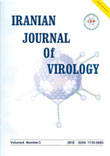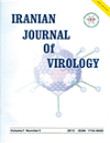فهرست مطالب

Iranian Journal of Virology
Volume:7 Issue: 1, 2013
- تاریخ انتشار: 1392/09/12
- تعداد عناوین: 7
-
-
Pages 1-6Background And AimsDespite the screening of blood donors, blood transfusion represents an ideal port of entry for blood-borne infection. Blood-borne pathogen transmission has been a concern since the earliest days of transfusion. The blood product of platelet (PLT) concentrates is still faced with the risk of bacterial and viral contaminations. Pathogen inactivation technologies offer a proactive approach and the potential to further improve blood safety. Here we study the pathogen inactivating capacity of riboflavin with UV light treatment in platelet concentrates contaminated with enveloped and non-enveloped viruses.Materials And MethodsThe inactivation effects of riboflavin in combination with UV light was examined on Herpes simplex virus (HSV), Vesicular stomatitis virus (VSV) and Polio virus classified as enveloped and non-enveloped DNA and RNA viruses, respectively. After spiking viruses in PLT concentrate, treatment was undertaken with riboflavin (50 µM) and exposed to different doses of UV light. Residual viral infectivity was titrated using 50%Tissue Culture Infective Dose (TCID50).ResultsCombination of Riboflavin and UV light treatment reduced the titer of HSV, VSV and Poliovirus with different doses of UV light. Log reduction of HSV with UV doses of 0.82, 1.63, 2.44 and 3.25 J/cm2 was 0.5, 1.3, 3.5 and 3.8, respectively. Log reduction of VSV for 0.82, 1.63, 2.44 and 3.25 J/cm2was 2.8, 3.8, 4.6 and 5.6, respectively. Also, log reduction of poliovirus for 0.82, 1.63, 2.44 and 3.25 J/cm2was 1.7, 2.5, 2.7 and 3.1 respectively.ConclusionThe final dose of UV (3.25 J/cm2) resulted in a larger amount of viral inactivation for enveloped and non-enveloped viruses, suspended in PLT. This method offers a potential to be used for prevention of the majority of PLT transfusion-associated viral pathogens.Keywords: Riboflavin, UV light, Platelet concentrate, Virus inactivation
-
Pages 7-14Background And AimsThe novel approaches in influenza vaccination have targeted more conserved viral proteins such as nucleoprotein (NP) to provide cross protection against all serotypes of influenza A viruses. Influenza specific cytotoxic T lymphocytes (CTL) are able to lyse influenza-infected cells by recognition of NP, the major target molecule in virus for CTL responses. On the other hand, studies suggest that fusing of molecular adjuvants such as Heat Shock Protein 70 (HSP70), member of intracellular chaperon super families, with an antigen can induce the cellular and humoral specific responses better than the same induced by antigen alone. It is shown that the C-Terminal of HSP70 (ctHSP70) is the main domain responsible for inducing immunity system.Materials And MethodsIn this study the open reading frame of NP gene from Influenza A virus (PR/8/34) and C-Terminal (359-625) domain of HSP70 gene from Mycobacterium tuberculosis were amplified and cloned into expression pET28a vector independently. Then the N-terminal of whole NP protein was fused to truncated HSP70 in same vector. The fidelity of cloned genes was confirmed by sequencing. All three types of clones were expressed in E. coli BL21 and confirmed by SDS-PAGE and Western blot analysis.ResultsResults showed the integrity of vector constructs and well expression of NP, ctHSP70 and fusion form of ctHSP70-NP recombinant proteins in BL21 host cells.ConclusionctHSP70-NP fusion protein produced could be considered and evaluated as a universal influenza vaccine which its immunogenicity potential needs to be assessed in animal models along with proper control groups including recombinant NP and ctHSP70 proteins.Keywords: Influenza virus, vaccine, Nucleoprotein, HSP70
-
Construction of Recombinant Bacmid DNA Encoding Newcastle Disease Virus (NDV) Fusion Protein GenePages 15-20Background And AimsNewcastle disease virus (NDV) is one of the major pathogen in poultry. Vaccination is intended to control the disease as an effective solution; nevertheless this virus is a growing threat to the poultry industry. F gene open reading frame (ORF) from NDV is 1650 bp, encoding a protein of 553 amino acids that can induce protective immunity alone. The F glycoprotein on the surface of NDV is important for virus infectivity and pathogenicity. Towards protection goal, the full-length of F gene was isolated using specific primers and cloned into the baculovirus derived bacmid shuttle vector to produce recombinant F-protein in insect cells.Materials And MethodsF gene ORF from avirulent strain La Sota of NDV was amplified by RT-PCR to produce F cDNA. The amplicon was cloned firstly into the T/A cloning vector and then subcloned into the pFastBac Dual donor plasmid through NcoI/KpnI sites. After the verification of cloning process by PCR and enzymatic digestion analysis, the accuracy of F gene ORF in the T/A cloning vector was confirmed by sequencing. Finally, F-containing recombinant bacmid was subsequently generated and confirmed by PCR using F specific primers and M13 universal primers.ResultsResults showed that a recombinant baculovirus containing a correct and in framework sequence of Newcastle F gene under the control of p10 promoter was constructed.ConclusionThe above mentioned F-containing recombinant baculovirus, in addition to its independent application, can be used with other individual recombinant baculoviruses expressing NH and NP genes to produce Newcastle VLPs in insect cell line.Keywords: Newcastle disease, F protein, Baculovirus, Bacmid shuttle vector
-
Pages 21-29Background And AimsAccurate and rapid diagnosis is necessary for central to effective control and prevention of foot-and-mouth disease (FMD). In present study, was evaluated real time reverse transcription-polymerase chain reaction (rRT-PCR) assay along with diagnostic routine methods for the detection of all seven serotypes of FMD virus (FMDV), namely O, C, A, SAT1, 2, 3 and Asia 1 in biological samples at the reference laboratory for FMD, Iran.Materials And MethodsTwo different rRT-PCR assays targeting two different regions 5´ untranslated region (5´-UTR) and RNA polymerase (3D) of the FMDV genome was used to confirm the presence of FMDV in epithelial suspensions.ResultsIn the two methods the viral RNA in all tested archival serotypes of FMDV were detected. Specificity of this reaction was confirmed by the use of swine vesicular disease virus and blue-tongue. The amount of cycle threshold (CT) value of all seven serotypes was different and the lowest and highest of CT value achieved for SAT3, A, O types and SAT2, C types, respectively.ConclusionThe results showed that rRT-PCR is more sensitive and effective than diagnostic routine methods. Furthermore, rRT-PCR as a strong and valuable tool concomitant with diagnostic routine methods facilitate monitoring of the fields FMDV strains and suggested the use of the multiple diagnostic targets could future enhanced the sensitivity of molecular methods for the detection of FMDV.Keywords: Foot, and, Mouth Disease Virus, ELISA, real, time PCR, conventional RT, PCR
-
Pages 30-36Background And AimsThe ectodomain of matrix protein of influenza virus is a weak immunogen that is highly conserved among all subtypes of influenza A virus. Tandem repeats of these genes along with linker were used to enhance immunogenicity of M2e protein and so it can be served as a universal vaccine in both humans and livestock.Materials And MethodsIn this study, the sequences of extra-domain of matrix protein of influenza A registered in NCBI was converted into codons compatible for Bacillus subtilis using JAVA codon adaptation tool software.ResultsA cassette consist of four repeats of this codon optimized sequence, spaced by appropriate linkers and flanked by BamHI and HindIII restriction sites was designed and thoroughly used for the synthesis. The cassette then was cloned into pMR12 shuttle expression vector.ConclusionTwo kinds of prokaryotic host, E. coli BL21and Bacillus subtilis WB600 were transformed by pMR12+4M2e. The fidelity of the construct in both transformants was confirmed by enzymatic analysis and PCR.Keywords: Influenza A, Matrix protein 2, Cloning, Bacillus subtilis, pMR12
-
Molecular and Serological Detection of Canine Distemper Virus (CDV) in Rural Dogs, IranPages 37-43Background And AimsCanine distemper (CD) is a deadly infectious disease of Canidae family. CD is a multi-systemic viral disease and is specified by wide range of clinical symptoms. The manifestations are not always indicative of CD, therefore a laboratory confirmation is necessary for suspected cases.Materials And MethodsDifferent clinical specimens of 19 CD suspected unvaccinated dogs were examined for canine distemper virus (CDV) infection by reverse transcription polymerase chain reaction (RT-PCR), Nested-PCR, and serum neutralization (SN) test during 2008-2011. RT-nested PCR assay was adjusted for detection of CDV nucleoprotein (NP) in prepared samples.ResultsIn samples of 3 out of 19 (15%) dogs, CDV NP gene was confirmed by RT-PCR while RT-PCR and combination with Nested-PCR (RT-nested PCR) presence of CDV NP gene was detected in various samples of 14 (73%) dogs. So efficiency of RT-PCR along with Nested-PCR raised 58%. Among different kinds of obtained samples, conjunctival swabs and kidney tissue biopsies were found to be suitable for analysis of CDV RNA. Additionally CDV antibody was detected in 11 out of 18 serum samples (61%) by SN test, but detection of neutralizing antibodies didn''t comply with RT-nested PCR results.ConclusionResults of this study indicated that Nested-PCR is a sensitive and applicable method for the diagnosis of CDV.Keywords: Canine Distemper Virus, RT, nested PCR, Nucleoprotein, Serum Neutralization Test


